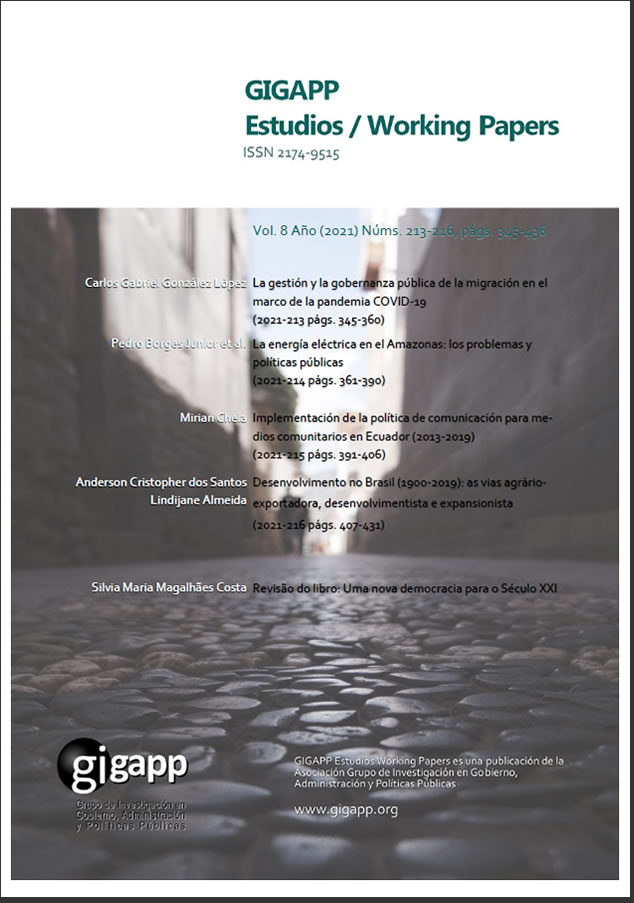La gestión y la gobernanza pública de la migración en el marco de la pandemia COVID-19
Resumen
El presente texto muestra un diagnóstico sobre la intervención de los Estados en la atención y gestión del fenómeno de la migración internacional en los primeros meses de la pandemia producida por la COVID-19 en 2020. Asimismo, realiza un comparativo entre las tendencias que se habían fijado en las agendas de gobierno, así como entre las distintas políticas y mecanismos en materia migratoria utilizados para controlar y mitigar la enfermedad producida por el virus del SARS-CoV-2. El desarrollo de la pandemia de la COVID-19, así como el incremento en el número de contagios y muertes, han incentivado a los Estados a implementar nuevas políticas y mecanismos en materia migratoria, fuera de los patrones que habían marcado a sus agendas de gobierno. Considerando esto, se plantea contestar a las siguientes preguntas: ¿Cuáles son y qué tipo de políticas han predominado? ¿Cuál es el contexto de la migración internacional durante la pandemia? y ¿Cuáles son los posibles escenarios futuros que enfrentará este fenómeno en el marco de su gestión y gobernanza?
Descargas
Citas
Agencia de la ONU para los Refugiados, 2019. Informe anual 2018. Madrid: ACNUR.
Aguilar Villanueva, L. F., 2013. El estudio de las Políticas Públicas. México: Miguel Ángel Porrúa.
Aguilar Villanueva, L. F., 2015. Gobernanza y Gestión Pública. México: Fondo de Cultura Económica.
Alba, F., 2008. El papel de los instrumentos internacionales sobre derechos humanos en la salva-guardia de los mismos. Revisa Interdisciplinaria de Movilidad Humana, 31, 37-61.
Alto Comisionado de las Naciones Unidas para los Refugiados., 2020. Medidas temporales e im-pacto en la protección. Obtenido de https://im.unhcr.org/covid19_platform/?lang=esp#_ga=2.259890062.589077426.1598485767-1107092665.1594944466
Arango, J., 2007. Las migraciones internacionales en un mundo globalizado. Vanguardia Dossier, 6-15.
Banco de México. 2020. Ingresos por Remesas. Obtenido de https://www.banxico.org.mx/SieInternet/consultarDirectorioInternetAction.do?accion=consultarCuadro&idCuadro=CE81&locale=es
BBC. 23 de abril de 2020. Coronavirus en EE.UU.: Trump suspende por 60 días la aprobación de "green cards" por la pandemia. BBC.
Comisión Mexicana de Ayuda a Refugiados. 2020. Solicitantes de la condición de refugiado en Mé-xico. Obtenido de https://www.gob.mx/comar/articulos/julio-2020?idiom=es
Covarrubias, M., 2019. Gobernanza Anticipatoria. México: Instituto Nacional de Administración Pú-blica.
Cruz Piñeiro, R., 2020. Algunas aproximaciones cualitativas para el estudio de la migración. México: El Colegio de la Frontera Norte.
Department of Economic and Social Affairs. 2019. Population Facts. Nueva York: United Nations.
Diario 20 Minutos. 11 de agosto de 2020. China permitirá la vuelta de nacionales europeos, entre ellos los españoles residentes en el país. Diario 20 Minutos.
Diario DW. 13 de mayo de 2020. China vuelve a cerrar otra ciudad de millones de habitantes luego de repunte de contagios. DW.
Durand, J., 2020. Procesos y patrones migratorios: Migración México - Estados Unidos. México: El Colegio de la Frontera Norte.
Farazmand, A., 1999. Globalization and Public Administration. Public Adninistration Review, 58(6), 509-522.
Forbes. 14 de julio de 2020. Gobierno de Trump abandona propuesta de expulsar a estudiantes ex-tranjeros. Forbes.
Ghosh, B., 2008. Derechos humanos y migración: el eslabón perdido. Migración y Desarrollo, 37-61.
Herrera Carassou, R., 2006. La perspectiva teórica en el estudio de las migraciones: economía y de-mografía. México: Siglo XXI Editores.
Instituto Nacional de Geografía y Estadística. 2019. Encuesta Nacional de Dinámica Demográfica ENADID 2018. México: INEGI.
Instituto Nacional de Migración. 2020. Mantiene INM coordinación con autoridades sanitarias en zonas de internación, estaciones y estancias migratorias de México. México: Boletín de Prensa.
La Jornada. 23 de junio de 2020. Vigilará Canadá granjas agrícolas ante contagio. LaJornada.
Magliano, M. J., 2011. La sociedad civil y la gobernabilidad de las migraciones en la agenda política sudamericana: el refugio en los derechos humanos. Espacio Abierto, 20(1), 5-23.
Massey, D., Durand, J., & Malone, N., 2009. Detrás de la trama. Políticas migratorias entre México y Estados Unidos. México: Miguel Ángel Porrúa.
Moloney, K., & Stone, D., 2019. Beyond the State: Global Policy and Transnational Administration. International Review of Public Policy, 1(1), 104-108.
Olson, R., 2016. Missing the Slow Train: How gradual change undemines public policy and collective action. Washington D.C.: Wilson Centre.
Organización Internacional para las Migraciones. 2006. Glosario sobre migración. Ginebra: OIM.
Organización Mundial de la Salud. 2020. Panorama desde la perspectiva de la salud. México: PNUD.
París Pombo, M., 2020. Sociedad civil y políticas migratorias con perspectiva de derechos huma-nos. Tijuana: El Colegio de la Frontera Norte.
París Pombo, M. D., 2020. Sociedad civil y políticas migratorias con perspectiva de derechos huma-nos. Tijuana: El Colegio de la Frontera Norte.
Pew Research Center. 2020. More than nine-in-ten people worldwide live in countries with travel restrictions amid COVID-19. Washington D.C.: Fact Tank.
Pew Research Center. 2020. With U.S.-Mexico border closed, migrant aprehensions fell by nearly half in April. Washington D.C.: Fact Tank.
Unidad de Política Migratoria, Registro e Identidad de Personas. 2019. Boletín estadístico de Soli-citante de Refugio en México. México: Secretaría de Gobernación.
Unión Interparlamentaria. 2015. Migración, derechos humanos y gobernanza. París: Oficina del Alto Comisionado para los Derechos Humanos.
United Nations. 2018. Global Compact for safe, orderly and regular migration. Obtenido de https://refugeesmigrants.un.org/sites/default/files/180713_agreed_outcome_global_compact_for_migration.pdf
Zenteno Quintero, R. 2020. Migración México-Estados Unidos. México: El Colegio de la Frontera Norte.
Derechos de autor 2021 Carlos Gabriel González López (Autor/a)

Esta obra está bajo licencia internacional Creative Commons Reconocimiento-NoComercial-CompartirIgual 4.0.
Aquellos autores/as que tengan publicaciones con esta revista, aceptan los términos siguientes:
a. Los autores/as conservarán sus derechos de autor y garantizarán a la revista el derecho de primera publicación de su obra, el cuál estará simultáneamente sujeto a la Licencia de reconocimiento de Creative Commons Attribution-NonCommercial-ShareAlike 4.0 International (CC BY-NC-SA 4.0) que permite a terceros compartir la obra siempre que se indique su autor y su primera publicación esta revista.
Con esta licencia de acceso abierto, los lectores (usuarios) pueden:
- Compartir — copiar y redistribuir el material en cualquier medio o formato
- Adaptar — remezclar, transformar y construir a partir del material
Bajo los siguientes términos:
-
Atribución — usarios deberán dar crédito de manera adecuada, brindar un enlace a la licencia, e indicar si se han realizado cambios. Puede hacerlo en cualquier forma razonable, pero no de forma tal que sugiera que usted o su uso tienen el apoyo de la licenciante.
-
NoComercial — usuarios no puede hacer uso del material con propósitos comerciales.
-
CompartirIgual — Si remezcla, transforma o crea a partir del material, usuarios deben distribuir su contribución bajo la misma licencia del original.
-
Sin restricciones adicionales: los usuarios no pueden aplicar términos legales o medidas tecnológicas que restrinjan legalmente a otros de hacer cualquier cosa que permita la licencia.
b. Los autores/as podrán adoptar otros acuerdos de licencia no exclusiva de distribución de la versión de la obra publicada (p. ej.: depositarla en un archivo telemático institucional o publicarla en un volumen monográfico) siempre que se indique la publicación inicial en esta revista
c. Se permite y recomienda a los autores/as difundir su obra a través de Internet (p. ej.: en archivos telemáticos institucionales o en su página web) antes y durante el proceso de envío, lo cual puede producir intercambios interesantes y aumentar las citas de la obra publicada. (Véase El efecto del acceso abierto).



